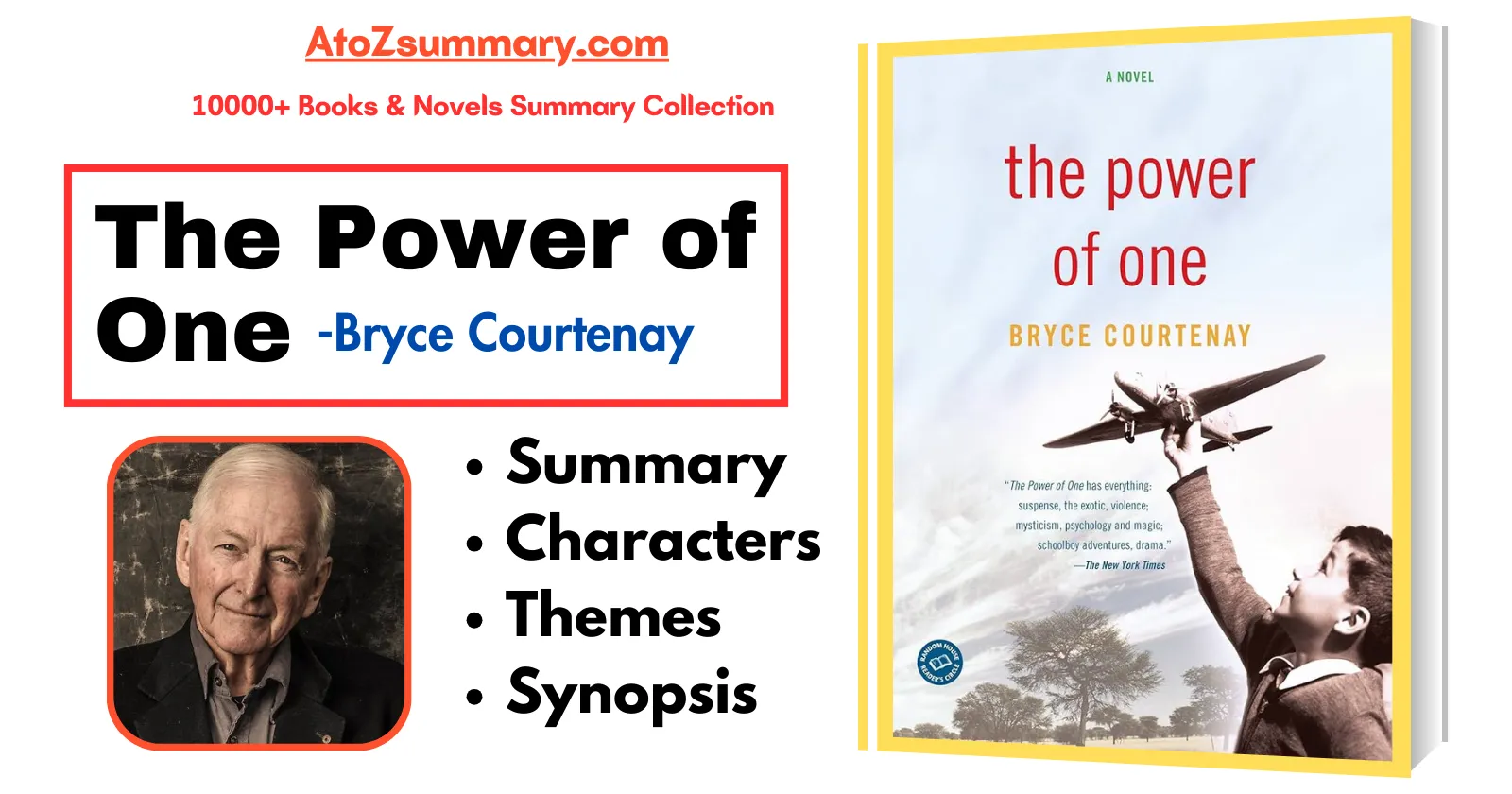Analysis
The Power of One by Bryce Courtenay is a coming-of-age novel set in South Africa during the 1930s and 1940s. It tells the story of Peekay, a young boy who overcomes great adversity to become a boxer and a champion for justice.
| Title | The Power of One |
| Author | Bryce Courtenay |
| Published Year | 1989 |
| Genre | Bildungsroman, Historical Fiction |
| Setting | South Africa, primarily during the 1930s-1950s |
Characters
The characters of “The Power of One” by are:
- Peekay (Peter Philip Kenneth Keith) ➤ The main character, a young boy who grows up in South Africa during apartheid. He’s determined, resilient, and becomes a talented boxer.
- Doc ➤ Peekay’s mentor and an influential figure in his life. He’s a German pianist and teaches Peekay important life lessons.
- Gideon Mandoma ➤ A boxer and Peekay’s friend. He helps Peekay train in boxing and supports him throughout the story.
- Morrie Levy ➤ Peekay’s Jewish friend and a brilliant student. He teaches Peekay about various subjects and shares his love for learning.
- Mrs. Boxall ➤ The kind librarian who encourages Peekay’s love for books and knowledge.
- Geel Piet ➤ A prisoner and boxer who becomes a mentor to Peekay in prison. He teaches Peekay about the art of boxing.
- Sergeant Bormann ➤ A cruel and racist prison warden who makes life difficult for Peekay and Geel Piet.
- Granpa Chook ➤ Peekay’s pet chicken and loyal companion throughout his childhood.
- Maria ➤ A black servant who cares for Peekay and plays a motherly role in his life.
- The Judge ➤ A mysterious character who influences Peekay’s life and boxing career.
Themes
The themes of “The Power of One” by are:
- Racism and Apartheid ➤ The book explores how racism and apartheid in South Africa affect people’s lives and the fight against these injustices.
- Individual Determination ➤ It shows how one person, Peekay, overcomes challenges through his determination and resilience.
- Mentorship and Role Models ➤ Peekay learns important life lessons from his mentors and role models, which shape his character.
- Importance of Education ➤ Education is portrayed as a powerful tool for personal growth and a way to combat discrimination.
- The Transformative Power of Sports ➤ The story highlights how sports, like boxing, can transform a person’s life and provide a path to success.
Synopsis
The Power of One is about a boy named Peekay growing up in South Africa during a time of racial segregation called apartheid. He faces bullying and racism but discovers his own inner strength through boxing and education. The story shows how one person can make a big difference in the world, even in difficult circumstances.
Summary
The story follows the exploits of Peekay, a South African child who speaks English, from the age of five to the age of seventeen between 1939 and 1951. The five-year-old Peekay is raised on a farm in the Natal area by his Zulu nanny Mary Mandoma & his grandfather when his mother experiences a mental breakdown. Soon after, he is transferred to an Afrikaans boarding school, where the other boys viciously torment him since he is the youngest pupil and the only one who speaks English. Peekay is punished for his bedwetting problem and his circumcised penis by the Judge, a senior kid named Jaapie Botha, and his so-called “stormtroopers” through continual verbal and physical abuse.
They refer to him in Afrikaans with pejorative terms such as “pickup” (piss head) and “rooinek” (redneck), which were terms used to refer to Englishmen during the Boer War, which was fought between the British & the Boers, or Afrikaners. The Judge, who has a swastika tattoo on his arm, persuades the defenseless Peekay that Hitler is out to drown all Englishmen and restore Afrikaner honor. Instead of providing consolation, Mevrou, the Afrikaans woman who manages the boarding home, wanders around wielding her lethal “sjambok” (cane stick).
After his first year of school, Peekay goes home, and his nanny hires the renowned Black chief Inkosi-Inkosikazi to address Peekay’s bedwetting problem. Inkosi-Inkosikazi not only succeeds in doing this, but he also allows Peekay access to a unique “dreaming” location with three waterfalls and 10 stones, where he may always be found. The next year, Peekay returns to school with his issue resolved, Granpa Chook, one of Inkosi-Inkosikazi’s magic chickens, and the self-sufficient spirit he refers to as the “power of one.”
Mevrou permits Granpa Chook to dwell in the kitchen where he controls the cockroaches and becomes Peekay’s sole companion at school. Peekay does exceptionally well in school, but he has discovered that to survive the system, one must adopt a camouflage, so he conceals his talent. Despite this, he quickly finds himself completing the Judge’s assignments, which only helps to boost his brilliance. This does nothing to lessen the Judge’s animosity towards Peekay; on the contrary, the Judge has Peekay consume human waste after the school year and use a catapult to murder Granpa Chook.
Peekay is traumatized and longs to get home to his nanny’s warm embrace. Mevrou, however, informs him that things have changed and that he now needs to travel to Barberton in the Eastern Transvaal, where his Granpa is waiting for him. When Mevrou takes Peekay to buy shoes before the trip home, Harry Crown, a Jewish guy, gives him the nickname “PK” since he thinks “Pisskop” is an unsuitable name for a young man.
Peekay encounters boxing champion of the railroads Hoppie Groenewald on the train to Barberton. On the route to Barberton, Hoppie stops at Gravelotte, where he shows Peekay his boxing gloves and encourages the youngster to witness him fight a man by the name of Jackhammer Smit. The idea of Peekay winning the title of world welterweight champion is formed. Hoppie’s proverbial “First with the head, then with the heart” instruction is committed to memory. Peekay’s mother meets him at the Barberton train station; she has recently returned from a mental facility and converted to Christianity.
Peekay learns through Dum and Dee, the Shangaan kitchen staff, that his nanny was fired by Peekay’s mother because she disobeyed the Lord. When Peekay’s mother tries to convert him, he scoffs at her and calls the Lord a “shithead.” Peekay encounters an elderly German music professor named Karl von Vollensteen in the hills behind his new home. He introduces himself as Doc and tells that he collects cacti. Along with Mrs. Boxall, the local librarian, Doc and Peekay became close friends. When Doc is sent to the Barberton jail because he failed to register as a foreign alien, Peekay visits him there to teach him music.
Peekay begins training in the prison’s boxing squad under the particular tutelage of Geel Piet, a man of color from the Cape. Peekay excels as a fighter quite early, inspiring the Barberton Blues to win. Peekay develops a black market strategy with Geel Piet and Doc for cigarettes and letters since he has a lot of sympathy for the Black inmates. Peekay becomes legendary among Black South Africans as a result, who consider him to be a chief known as the “Onoshobishobi Ingelosi” or “Tadpole Angel.”
One night Peekay learns Geel Piet has been killed in the boxing gym by the vicious warder Borman, and one of the white jail wardens feels that there is some illicit activity going on. When World War II is over, Doc is once more liberated. Doc, Mrs. Boxall, and a Jewish instructor named Miss Bornstein help Peekay refine his brilliant mind via chess, physics, music, and literature. Peekay wins the Eastern Transvaal under-12 boxing championship in addition to passing his Royal College of Music examinations, much to the surprise of the community. Peekay obtains a scholarship at the esteemed Prince of Wales school in Johannesburg with the assistance of his mentors.
Peekay’s time at the Prince of Wales school is detailed in Book Two of the book. He rapidly forms a partnership with Morrie Levy, a Jewish multimillionaire’s son. Peekay and Morrie completely transform the Prince of Wales boxing squad thanks to Peekay’s boxing skills, and Morrie takes over as Peekay’s manager. In little time at all, the two lads have a successful gambling operation up and running, along with a variety of other “scams” that generate enough income for Peekay to start boxing training with South Africa’s best trainer, Solly Goldman. Peekay develops a fear of failure and achieves success in boxing, rugby, and academics. But as his academic career draws to a close, he must deal with Doc’s passing and the sadness of not being awarded a Rhodes scholarship to attend Oxford University.
Book Three follows the life of Peekay in Northern Rhodesia (modern-day Zimbabwe), where he accepts a perilous (though profitable) work as a “grizzly man” in the mines to build up his physique for boxing and to make enough money to fund his three-year Oxford education. Rasputin, a Russian miner he becomes good friends with, rescues Peekay from a mining disaster by sacrificing himself in the process. Before leaving the mines, Peekay heals but learns that he has been working with Jaapie Botha, his longtime foe. Jaapie is defeated by Peekay in a battle. Peekay chisels a Union Jack and the initials “PK” over Botha’s Nazi tattoo.
FAQs
What is the novel The Power of One about?
The novel is about a young boy named Peekay who overcomes great adversity to become a boxer and a champion for justice in South Africa during the apartheid era.
What challenges does Peekay face?
Peekay faces many challenges throughout his life. He is bullied and harassed at school, and he also experiences the injustices of apartheid. However, he never gives up on his dreams, and he eventually becomes a successful boxer and a champion for justice.
What is the significance of the title “The Power of One”?
The title reflects the idea that one person can make a significant impact on the world, emphasizing individual strength and resilience.
Has “The Power of One” been adapted into other forms of media?
Yes, it was adapted into a film in 1992, directed by John G. Avildsen.
What is the lasting message of the novel?
The novel conveys the message that even in challenging circumstances, one person’s determination and belief in themselves can lead to positive change and personal growth.











